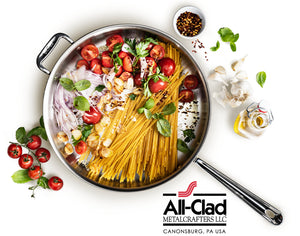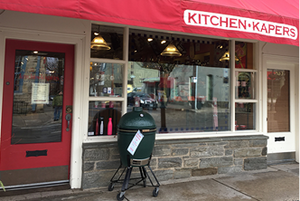So we've done the research and testing for you, putting the 5 safest, and most proven methods to remove the unsightly remnants of meals past. Got stained stainless, crummy cast iron or nasty nonstick? Just read on to see our best recommendation for bringing most types of cookware back from the brink, along with recommendations for everyday cleaning.
And never mind thanking us- send cookies instead.
First, here's a quick rundown of the cleaning solutions we used and our overall impression of each.To be clear, none of the cleaners we tested offer the wipe-on-wipe-off, stain erasing power of aggressive, commercial-type cleaners such as "Oven-Off" or "Carbon-Off". But they also won't melt the kitchen counter, leave you gasping for air, and poison the Earth when disposed. So it's a good trade-off. All are safe to use (you should still use gloves, since each is mildly abrasive) and all work best with a fair amount of elbow grease and a little patience. We based our findings on a single application and only used nylon scrubbies, double-sided sponges or brushes to scrub.
1-Barkeepers Friend
"BKF" is the best for removing burnt-on stains from aluminum, anodized aluminum and stainless steel. And we have to add that it's really inexpensive- everyone should have a few cans of this at home. This long-established cleaning powder is a little more abrasive than the other solutions we tried, but it's still a good choice for any cookware. If you can supply the elbow grease, Barkeeper's Friend will make your aluminum sheet pans and muffin tins look presentable again.
2-Astonish
A very good performer on everything, but our top pick for enamel-coated cookware. This cleaning paste stays where you put it, and can be actively scrubbed into stains to visibly pick up grease and diminish carbonized spots. The added moisture makes it less abrasive than Barkeeper's Friend, and kinder to shiny, polished surfaces.
3-Baking soda and Peroxide
The best natural multi-purpose cleaner you can make at home. Here's the recipe:
- 1/2 Cup baking soda
- 1 teaspoon liquid dish soap
- 1-2 tablespoons hydrogen peroxide
Simply mix the ingredients together in a small bowl. It should have a light, foamy consistency that's similar to fresh whipped cream. The key to this home-made concoction is patience. If you apply it and allow the soft, bubbling action go to work for 10 minutes or more, it will pick up food residue and diminish grease stains with a good scrub. We were very impressed with the amount of heavy carbon build-up it can penetrate and break up if you let it sit long enough. It will definitely help with grease and food residue too, but multiple applications and patience may be necessary.
4-Baking soda and water
The perfect gentle solution for ceramic-based nonstick surfaces. Beyond that, it's just an okay cleaner. But it is very safe and versatile enough to use on anything, and chances are it's just sitting in your cabinet, so props for that. For cookware other than ceramic nonstick, be sure to let it sit on stains for a while, then scrub vigorously. Multiple applications may be necessary.
5-Coarse salt and cooking oil
This simple abrasive won't help with baked-on grease or carbonized spots, but it's perfect for knocking burnt-on food debris from raw cast iron and carbon steel pans with minimal impact on the seasoning layers. Just be sure to use a brush, paper towel or dish cloth to apply- no scrubbies!
Types of Cookware
Stainless steel

Whether it's All-clad or Farberware, stainless steel cookware can get plenty grimy. Not only can food and grease residue build up inside the pan, but the underside can develop a hazy layer of grease and/or blackened stains from gas cooktops. And the dishwasher will never help. But the great thing about stainless steel is that it is a relatively hard and smooth surface that can handle a little abrasiveness, so chances are good that even bad stains can scrub perfectly clean in the sink with the right cleaner. We had excellent results with Barkeeper's Friend and a nylon scrubby, and it went to work right away. You can make the work go easier by soaking the pan in a shallow bath of hot water for a few minutes first. Drain off the water and add a shake or two of BKF to the stained areas and work the powder into the stain with the scrubby. There should be enough residual moisture on the pan to turn the powder into a paste, or moisten the scrubby if needed. Then get to scrubbing! Remember, a circular motion works best and it is easier to work on a single spot or section at a time. Our test pieces suffered from both food residue and baked-on grease and Barkeeper's Friend got rid of both. But be aware, if your stainless steel pieces are highly polished, or "mirror" polished, and you would like to keep them that way, try Astonish cleaner and a washcloth instead. It also did a great job on stainless, though we recommend you apply it to stains and then allow it to sit for 10 minutes before scrubbing for best results. Astonish seems to require more time to break down grease, but the results were great and it seems to be gentler on surfaces. Please note that BKF can scratch highly polished stainless steel and would eventually leave your cookware looking a bit hazy or "brushed". For everyday washing, we recommend hot water, dish soap and a scrub sponge.
Enameled Cast Iron/Enameled Steel

Have those gorgeous colors become crusted over with residue and pitch-black stains? Don't worry, it's not you. Enameled pieces, particularly enameled cast iron, can get very hot and the cookware usually remains hotter longer, so grease and food particles tend to bake on in fewer uses. Enamel is strong stuff, but the very hard, glass-like surface can still scratch into a hazy, dull finish, so harsh abrasives aren't an option. That's why we recommend Astonish Cleaner. It's not quite the bargain that Barkeeper's Friend is, but it is very effective and works with less abrasivity. Keep a container in reserve for your favorite stainless, enamel or anodized aluminum pieces, you should only need to use it occasionally to keep stains in check.
*Some enameled cast iron cookware has a lightly colored interior (such as many Le Creuset pieces). After years of use, dark stains can develop on the cooking surface, and they stand out like a sore thumb against the sand or grey-colored interiors. These stains should not affect the performance of the cookware, nor the flavor or color of the dishes prepared within, but they look terrible! The only manufacturer-approved method for removing these stains (that we have found), is to soak in a bleach solution. We would suggest starting with one part bleach to 3 parts water. Pour the solution into your pot or skillet, and allow it to sit overnight or up to a day. If the stain is very stubborn, you can increase the bleach to water ratio, but do not exceed 50/50 or you risk permanently damaging the enamel. Repeated applications may be necessary to completely eliminate the stain. And when the job is done, be sure to rinse the pot very thoroughly, wash well and rinse again before storing or using.
Anodized Aluminum

Right off the bat, these hardened aluminum pieces have a smooth, dark surface that is not only easier to clean, but is also likely to hide stains up to a point. But you may still notice light or dark blotches baked onto the sides and bottom. Barkeeper's Friend, a scrub sponge and elbow grease did a fantastic job for us. If you have anodized aluminum cookware that has a PTFE nonstick surface, be sure to only use the BKF on the anodized aluminum exterior and not on the PTFE surface.
PTFE Nonstick (Teflon)
If your PTFE (Teflon-type) nonstick cookware is in good, smooth or new condition, daily cleaning should be a breeze. Two things that you should NOT do are:
1: clean it in the dishwasher; and
2: use any type of abrasive
The best way to clean a PTFE nonstick surface after regular use is to begin soon after use- ideally while it is still warm. Use hot water and a soapy sponge or dish cloth to wipe it out well, being sure to get the entire interior soapy. The cloth or sponge should be sufficient to remove any food residue from a working PTFE surface, and the dish soap will break down and remove any grease. Also be sure to get hot soapy water around the handle joint and rivets to help prevent the development of baked-on stains. You can use a scrubbie for the handle and exterior, along with the best cleaner recommended for your cookware's material.
Ceramic Nonstick

The key to preserving ceramic nonstick's slippery performance is to keep it clean. And we mean really clean. Plus, you have to do that without abrasives, and without putting it in the dishwasher (for a complete list of do's and don'ts, learn our Little-Known Tips That Help Nonstick CookwareStay Nonstick). For general cleaning, use hot water, dish soap and a dish cloth. Give special attention to the whole interior surface to remove any residual cooking fats. If residual cooking fats remain on the pan and bake into the nonstick surface, then adios slippery interior. It's that simple. Now if food residue builds up, we have a great way to gently scrub your pan back to bright perfection: baking soda and water. Add just enough water to make a slurry-like consistency and wipe the mixture into the pan with a soft cloth or paper towels, then rinse well.
Aluminum Pans, Cookie Sheets and Muffin Pans

I use aluminum sheet pans for everything from cookies to roasts. And while I typically use parchment paper to make cleaning easier, it's only a matter of time before the edges and corners of the pan become freckled and bronzed with baked-on grease. Even the underside! I've no idea how that happens. But I do know how to clean it off. Soak your bare aluminum in hot water for about ten minutes, drain it off, add a few shakes of BKF and scrub away with a scrub sponge. You've got to put some arm into it, and as always, focus on sections at a time. A scrub sponge is better than a nylon scrubby because it will compress more easily into the corners of pan walls and the creases of rolled rims. Re-soak the pan in between sections to keep the pan temperature up. This combination works every bit as good as steel wool, but without tearing up the surface of the pan, or your hands. Bare aluminum is a soft and porous material, so to a degree, stains are inevitable. Barkeeper's Friend is the best way to scrub away stains when needed. But for regular washing, just focus on removing all grease before it gets stored or used again- that means plenty of soapy hot water and a sponge or cloth.
Raw Cast Iron and Carbon Steel
If you own and use raw cast iron or carbon steel cookware, it's probably reasonable to assume that you already know all about "seasoning". And if you don't, learn everything you need to know here. The trick to cleaning cast iron and carbon steel is to do it without washing away, or otherwise damaging the seasoning layers. Seasoning layers are made up of polymerized fats, which are essentially "baked on" until they dry into the pan surface, encasing the entire pan. This semi-permanent barrier protects against rust and gives this special cookware naturally nonstick performance.
The picture on the left shows how soaps and abrasives will deteriorate the layers of polymerized fats (aka "seasoning") on carbon steel. Dish soap is formulated to break down fats, so it's vital that you keep it away from your seasoned cookware. Typical cleaning is best accomplished with hot water and a stiff-bristle brush. We also highly recommend the Pan and Grillpan Scraper Set for easy removal of crusted-on food debris. Made by Lodge, these inexpensive, contoured, thick, durable polycarbonate scrapers are great for cleaning any brand of cast iron or carbon steel cookware, and even the ribs of grill pans.
But meanwhile, if crusted-on food debris is giving you trouble, add about a tablespoon of coarse salt and a tablespoon of cooking oil to the stained areas and scrub with a cloth or paper towel. The salt is usually abrasive enough to scour food away, while the oil lubricates everything and helps your seasoning survive. When the debris is gone, simply wipe out the pan thoroughly and dry well by heating the pan up on the range or in the oven.
- Cleaning gloves are good! Not only will they protect your skin from drying out, but you'll likely do a better job cleaning because you'll be more comfortable and there is less "ickk" factor.
- All cookware cleans easier and more completely when it is still warm from use, and typically a soapy sponge or dishcloth and hot running water are all you need to remove grease and food residue. Procrastinate, and you'll have to work harder.
- Always give a light scrub to the bottom of the piece and to the handle joint, even if they don't appear to be soiled from use.
- If a pan is used to sear, or otherwise develops a caramelized, dark or blackened crust from cooking, be sure to (once the food is removed) set the cookware back on the range, add enough water to cover the stains and a small amount of dish soap. This will prevent the residue from drying on to the pan and make cleaning much easier later. If conditions allow you to heat the pan and let it simmer for a while, it may even dissolve the stain completely.




